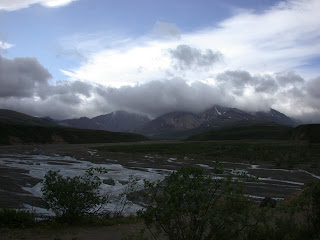We spent 5 days and 4 nights in Whitehorse, Yukon Territory. The first night was free, or they call it “dry camping”, in the Wal-Mart parking lot after we stocked up on groceries. Our next two nights were in an RV park while we scouted the local sites. Downtown Whitehorse is pretty small, about 3 blocks wide and 8 blocks long, but it’s the largest city and the capital of the Yukon Territory. Every day in the small city park, ¼ block, they provide free entertainment. The first day was a group of natives, performing native songs and dancing. The next day we returned and were entertained by old time fiddles and a guitar.
 |
| Downtown Whitehorse, Yukon Capital |
After lunch at Tim Horton’s, we drove to Miles Canyon and the suspension bridge over the Yukon River gorge where we hiked along the Yukon River where gold seekers of the late 1800’s used river pilots to help them through the canyon on their way to certain riches; which wasn’t to be for the vast majority.
 |
| Yukon River suspension bridge at Miles Canyon |
 |
| June on suspension bridge |
Our third night, after two nights in the RV Park, we stayed again in the Wal-Mart parking lot. It rained most of the night and all day, so we visited a couple museums. The Yukon transportation museum; a history of transportation in the Yukon from the gold rush days to more recent times which placed emphasis on airplane travel and the Alaska highway.
We then visited the Yukon Beringia Interpretive Center. Beringia is the name given to that large area of ice and land that at one time connected Alaska to Russia, and was much larger than Alaska today. The history was pretty fascinating as it explained how animals crossed what are now the Bering straits, evidence through excavations, and geological studies of the earth’s movement, etc.
While the rain was subsiding, we took a 4:00 tour of Yukon Brewing, a very small brewery with claims as being the number one beer in the Yukon. At the end of the tour, we were able to taste each of 8 different beers they make here. After this tour, it was just a couple blocks to the Wal-Mart lot so we took advantage of the rate, $0, and felt safer with less driving after all that beer tasting.
 |
| Whitehorse Walmart |
Day 5 was at the Yukon Arts Center where the Kluane Bluegrass festival was being held. We drove over at about 9:00 A.M. to get a good spot and found the lot virtually empty, except for a couple other RV’s. Entertainment was scheduled to begin at 10:00 in an outdoor tent, so at 9:45 we strolled over to the tent that was set up with about 20 chairs and found a couple good ones (we were first to arrive) and listened to Dill & The Pickles play mostly Irish songs until 11:00. By then the crowd had swelled to maybe twenty or so dedicated bluegrass fans.

We did get to play along in what they called a “Slow Jam”, designed for beginners, but we all had fun, all 12 of us, along with an audience that looked like 30 waiting for the 12:00 show to start in the auditorium. June and I walked to the RV for lunch, then back to the tent at 1:30 where a contest was scheduled for bands to compete for a place on next year’s stage at this same event. The winning group was all female, a guitar – bass – banjo – mandolin – fiddle; and, they were really very good. These professional sounding ladies took first place by a landslide. Oh, they were the only entry, but they were very good anyway.
 |
| Contest Winners |
After the contest, we decided to head out of town and find a spot to Dry Camp one more night, which we did find a good spot in a very large gravel turnout on the Alaska Highway about 40 miles outside of Whitehorse. We had two other RV’s and a tent at the other far end of the area, plus wall to wall mosquitoes. We were fairly well protected inside, but some of those pesky things did find their way in but met their bloody end by my hand and a fly swatter.


















































